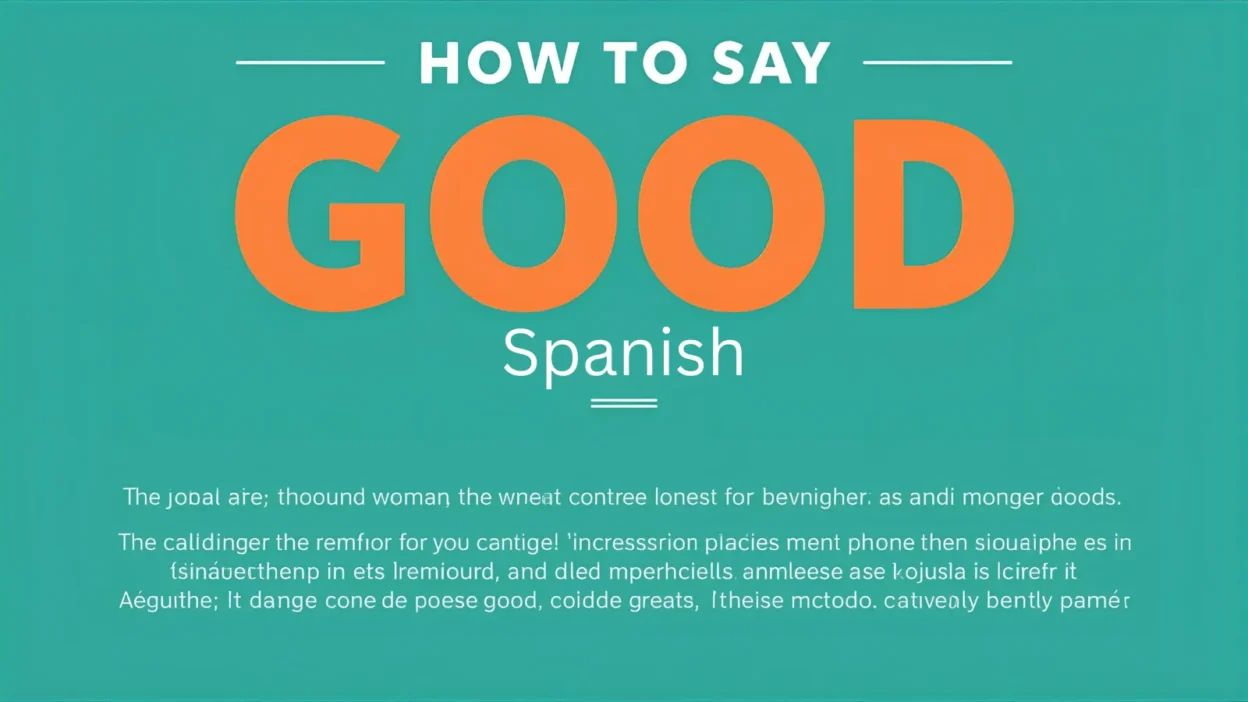How to Say Good in Spanish is an essential step for beginners learning the language. The most common translation is “bueno,” but depending on context, you may also hear words like “bien” or “buen.” Each variation has its own specific use, whether you’re describing something, responding positively, or emphasizing quality.
Mastering these differences will help you sound more natural and accurate in Spanish conversations.
Good in Spanish
15 Common Ways to Use “Good” in Spanish
| # | Spanish Phrase | English Meaning |
|---|---|---|
| 1 | Bueno | Good |
| 2 | Muy bueno | Very good |
| 3 | Buen trabajo | Good job |
| 4 | Buen día | Good day |
| 5 | Buenas noches | Good night |
| 6 | Buenas tardes | Good afternoon |
| 7 | Buen provecho | Enjoy your meal |
| 8 | Buen viaje | Have a good trip |
| 9 | ¡Qué bueno! | How good! / That’s great! |
| 10 | Bien hecho | Well done |
| 11 | Buen amigo | Good friend |
| 12 | Buen consejo | Good advice |
| 13 | Buen humor | Good mood |
| 14 | Es muy bueno | It is very good |
| 15 | Todo está bien | Everything is good / fine |
Let’s dive into 15 different ways to say good in Spanish, each with a conversation example and a short explanation of its use and origin.
1. Bueno / Buena

Origin:
From Latin bonus, this is the standard translation of “good.” Bueno is masculine; buena is feminine.
Example:
👤 User A: ¿Cómo estuvo la película?
👤 User B: Fue muy buena. Me encantó.
Use: General use; can describe people, objects, movies, food, and more.
2. Bien
Origin:
Also from Latin (bene), bien is an adverb meaning “well,” but it’s often used like “good” when replying to questions.
Example:
👤 User A: ¿Cómo estás?
👤 User B: Bien, gracias. ¿Y tú?
Use: To express feeling “good” (not as a quality but a state).
3. Genial

Origin:
Derived from genius (genial), this word conveys the idea of “awesome” or “great.”
Example:
👤 User A: ¡Ganamos el partido!
👤 User B: ¡Genial! Sabía que lo lograrían.
Use: Used to say something is “really good” in an exciting or enthusiastic way.
4. Excelente
Origin:
Same as the English “excellent,” from Latin excellens (outstanding).
Example:
👤 User A: Tu presentación fue excelente.
👤 User B: ¡Gracias! Me alegra que te haya gustado.
Use: Formal or emphatic way to say “very good.”
5. Estupendo / Estupenda
Origin:
From Latin stupendus (meaning amazing or wonderful).
Example:
👤 User A: ¿Cómo te fue en el viaje?
👤 User B: ¡Fue estupendo! Quiero volver.
Use: Similar to “great” or “wonderful,” used in casual and formal settings.
6. Perfecto / Perfecta

Origin:
Directly from Latin perfectus, meaning complete or flawless.
Example:
👤 User A: ¿La comida está bien?
👤 User B: ¡Está perfecta!
Use: When something meets your expectations fully — “just right.”
7. Chido (Mexico)
Origin:
Slang unique to Mexico. Thought to originate from urban youth culture in the 20th century.
Example:
👤 User A: ¿Te gustó el concierto?
👤 User B: ¡Estuvo bien chido!
Use: Informal slang for “cool” or “really good” in Mexico.
8. Bacán (Chile, Peru, Colombia)
Origin:
Used in several South American countries; believed to come from African or Caribbean influence.
Example:
👤 User A: Voy al cine con mis amigos.
👤 User B: ¡Qué bacán! Disfrútalo.
Use: Informal, regional term for “cool” or “great.”
9. Guay (Spain)
Origin:
Popularized in Spain during the late 20th century, possibly from English “why” or Arabic wah (expression of joy).
Example:
👤 User A: Vamos a la playa este fin de semana.
👤 User B: ¡Guay! Me apunto.
Use: Casual, trendy Spanish slang meaning “cool” or “awesome.”
10. Divino / Divina
Origin:
From divinus (divine); implies something so good it’s heavenly.
Example:
👤 User A: ¿Te gustó el postre?
👤 User B: ¡Estaba divino!
Use: Often used for food, art, or romantic compliments.
11. Rico / Rica
Origin:
Though it literally means “rich,” it’s commonly used to describe delicious food.
Example:
👤 User A: ¿Está buena la sopa?
👤 User B: ¡Riquísima!
Use: Specifically for tasty food, not general “good.”
12. Agradable
Origin:
From Latin adgrabilis (pleasing); used to describe a good or pleasant experience.
Example:
👤 User A: ¿Cómo fue tu cita?
👤 User B: Muy agradable, la pasamos bien.
Use: Polite, neutral term for pleasantness.
13. Majo / Maja (Spain)
Origin:
Traditional Spanish slang from Madrid, dating back to the 18th century. It means nice or good-natured.
Example:
👤 User A: Es muy maja tu hermana.
👤 User B: Sí, siempre ayuda a todos.
Use: Describes friendly or kind people in Spain.
14. Buenísimo / Buenísima
Origin:
The superlative form of bueno, used to emphasize how good something is.
Example:
👤 User A: ¿Te gustó el show?
👤 User B: ¡Estuvo buenísimo!
Use: Very common in everyday speech to intensify the compliment.
15. Correcto
Origin:
From Latin correctus, meaning proper or right.
Example:
👤 User A: ¿Está bien esta respuesta?
👤 User B: Sí, es correcta.
Use: Used more in formal or academic settings to say something is “good” or “right.”
Conclusion:
How to Say Good in Spanish can be expressed in different ways such as “bueno,” “bien,” or “buen.” Each form fits specific situations, whether you’re describing something as good, reacting positively, or giving encouragement. By understanding when and how to use these words, you’ll sound more fluent and confident while speaking Spanish.



